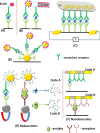Towards in vitro molecular diagnostics using nanostructures
- PMID: 22009454
- PMCID: PMC11115035
- DOI: 10.1007/s00018-011-0855-7
Towards in vitro molecular diagnostics using nanostructures
Abstract
Nanostructures appear to be promising for a number of applications in molecular diagnostics, mainly due to the increased surface-to-volume ratio they can offer, the very low limit of detection achievable, and the possibility to fabricate point-of-care diagnostic devices. In this paper, we review examples of the use of nanostructures as diagnostic tools that bring in marked improvements over prevalent classical assays. The focus is laid on the various sensing paradigms that possess the potential or have demonstrated the capability to replace or augment current analytical strategies. We start with a brief introduction of the various types of nanostructures and their physical properties that determine the transduction principle. This is followed by a concise collection of various functionalization protocols used to immobilize biomolecules on the nanostructure surface. The sensing paradigms are discussed in two contexts: the nanostructure acting as a label for detection, or the nanostructure acting as a support upon which the molecular recognition events take place. In order to be successful in the field of molecular diagnostics, it is important that the nanoanalytical tools be evaluated in the appropriate biological environment. The final section of the review compiles such examples, where the nanostructure-based diagnostic tools have been tested on realistic samples such as serum, demonstrating their analytical power even in the presence of complex matrix effects. The ability of nanodiagnostic tools to detect ultralow concentrations of one or more analytes coupled with portability and the use of low sample volumes is expected to have a broad impact in the field of molecular diagnostics.
Figures





Similar articles
-
One-dimensional nanostructures based bio-detection.Biosens Bioelectron. 2015 Jan 15;63:432-443. doi: 10.1016/j.bios.2014.07.043. Epub 2014 Jul 24. Biosens Bioelectron. 2015. PMID: 25128623 Review.
-
Nanostructures in biosensor--a review.Front Biosci (Landmark Ed). 2011 Jan 1;16(3):997-1023. doi: 10.2741/3731. Front Biosci (Landmark Ed). 2011. PMID: 21196214 Review.
-
25th anniversary article: label-free electrical biodetection using carbon nanostructures.Adv Mater. 2014 Feb 26;26(8):1154-75. doi: 10.1002/adma.201304912. Epub 2014 Jan 22. Adv Mater. 2014. PMID: 24452968 Review.
-
Nucleic acid conjugated nanomaterials for enhanced molecular recognition.ACS Nano. 2009 Sep 22;3(9):2451-60. doi: 10.1021/nn9006303. ACS Nano. 2009. PMID: 19658387 Free PMC article. Review.
-
Recent developments and patents on biological sensing using nanoparticles in microfluidic systems.Recent Pat Nanotechnol. 2013 Jan;7(1):81-90. Recent Pat Nanotechnol. 2013. PMID: 22974430 Review.
Cited by
-
Nanowire-Based Biosensors: From Growth to Applications.Micromachines (Basel). 2018 Dec 19;9(12):679. doi: 10.3390/mi9120679. Micromachines (Basel). 2018. PMID: 30572645 Free PMC article. Review.
-
A Review of Nanowire Devices Applied in Simulating Neuromorphic Computing.Nanomaterials (Basel). 2025 May 11;15(10):724. doi: 10.3390/nano15100724. Nanomaterials (Basel). 2025. PMID: 40423114 Free PMC article. Review.
-
Lanthanide nano-drums: a new class of molecular nanoparticles for potential biomedical applications.Faraday Discuss. 2014;175:241-55. doi: 10.1039/c4fd00117f. Faraday Discuss. 2014. PMID: 25284181 Free PMC article.
-
Nanotechnologies for In Vitro IgE Testing.Curr Allergy Asthma Rep. 2017 Jul;17(7):50. doi: 10.1007/s11882-017-0717-y. Curr Allergy Asthma Rep. 2017. PMID: 28623535 Review.
-
On the Use of Scalable NanoISFET Arrays of Silicon with Highly Reproducible Sensor Performance for Biosensor Applications.ACS Omega. 2016 Jul 31;1(1):84-92. doi: 10.1021/acsomega.6b00014. Epub 2016 Jul 12. ACS Omega. 2016. PMID: 30023473 Free PMC article.
References
-
- Veenstra TD, Yates JR. Proteomics for biological discovery. New Jersey: Wiley; 2006.
-
- Campbell MA, Heyer LJ. Discovering genomics, proteomics and bioinformatics. New Jersey: Benjamin Cummings; 2002.
-
- The human genome project, http://www.ornl.gov/sci/techresources/Human_Genome/home.shtml (21 March 2011)
Publication types
MeSH terms
Substances
LinkOut - more resources
Full Text Sources

